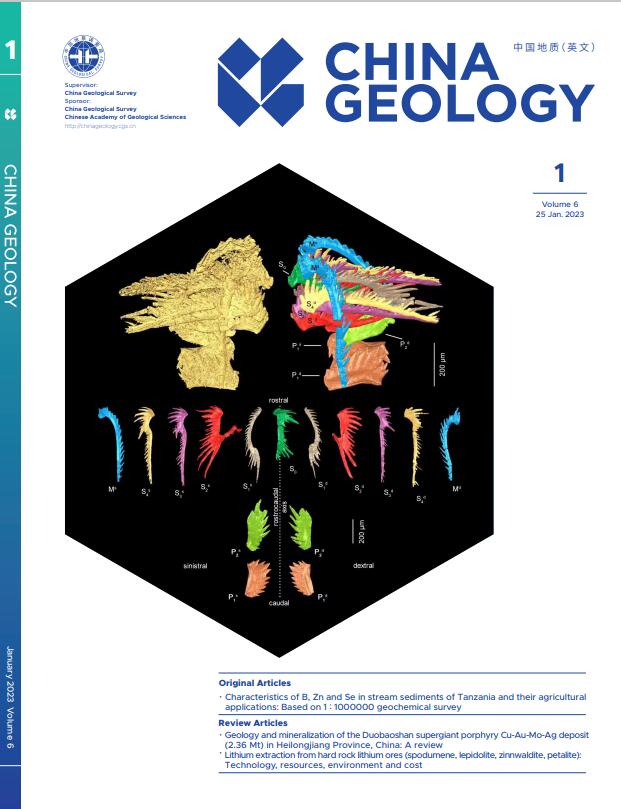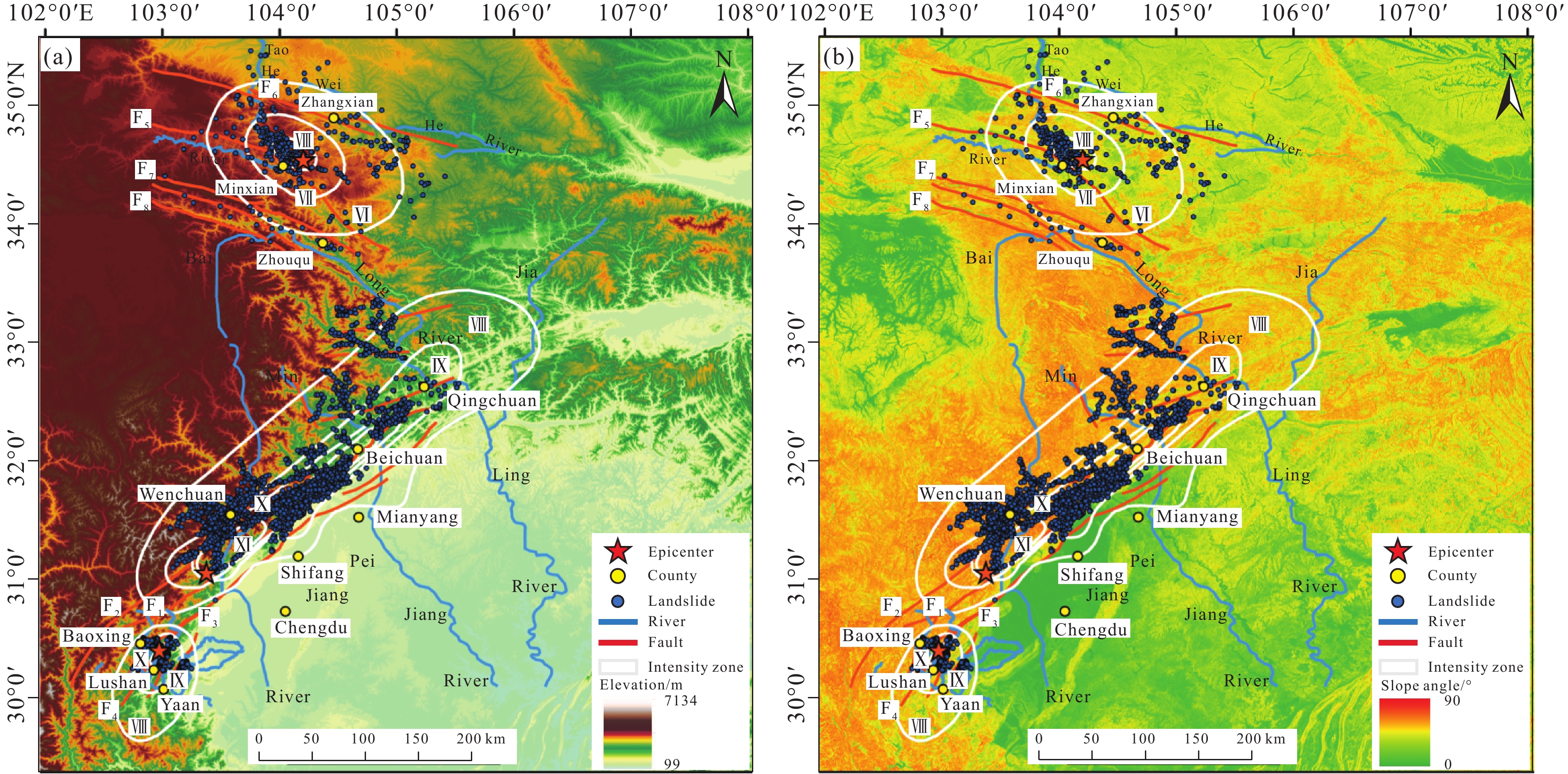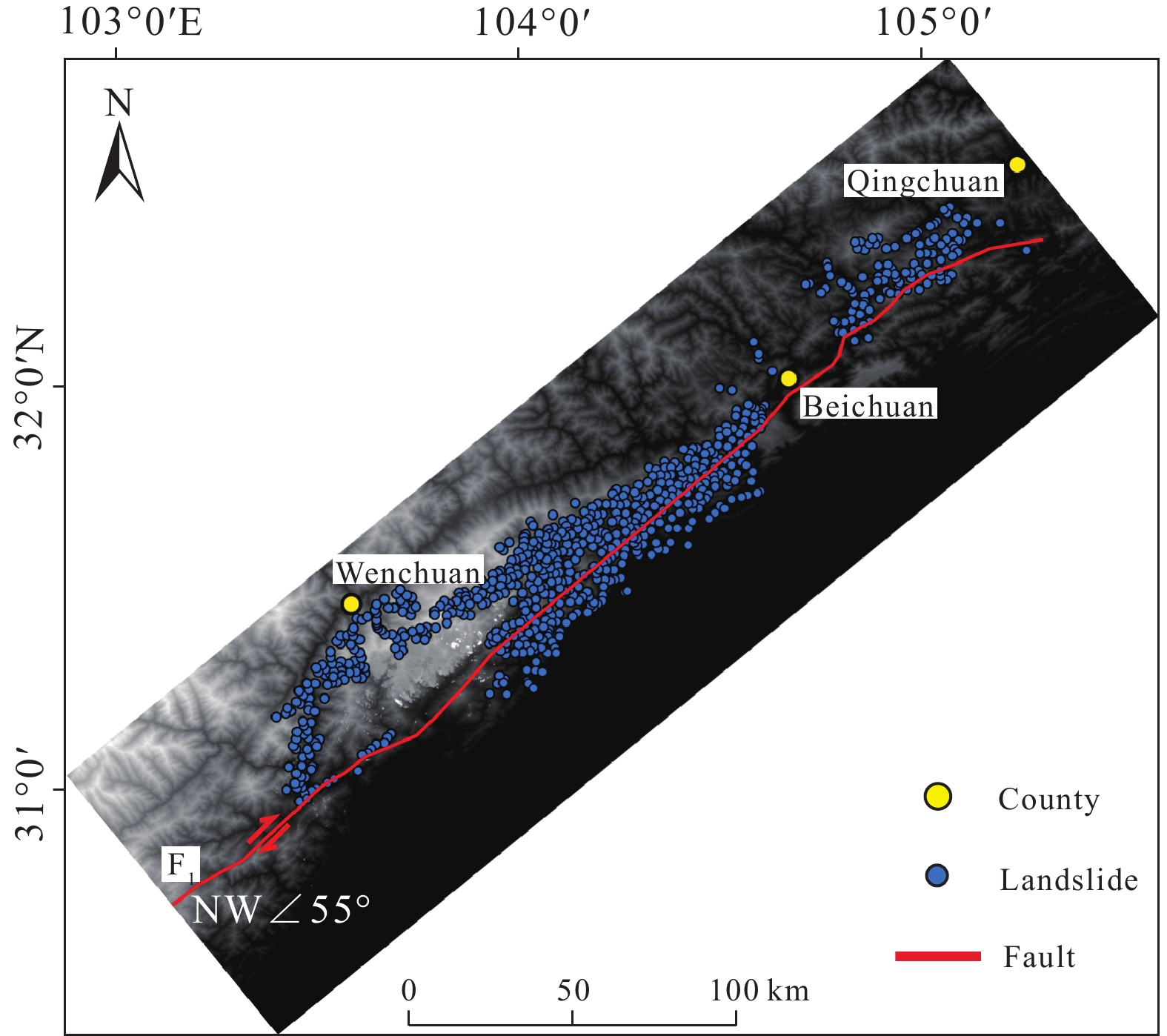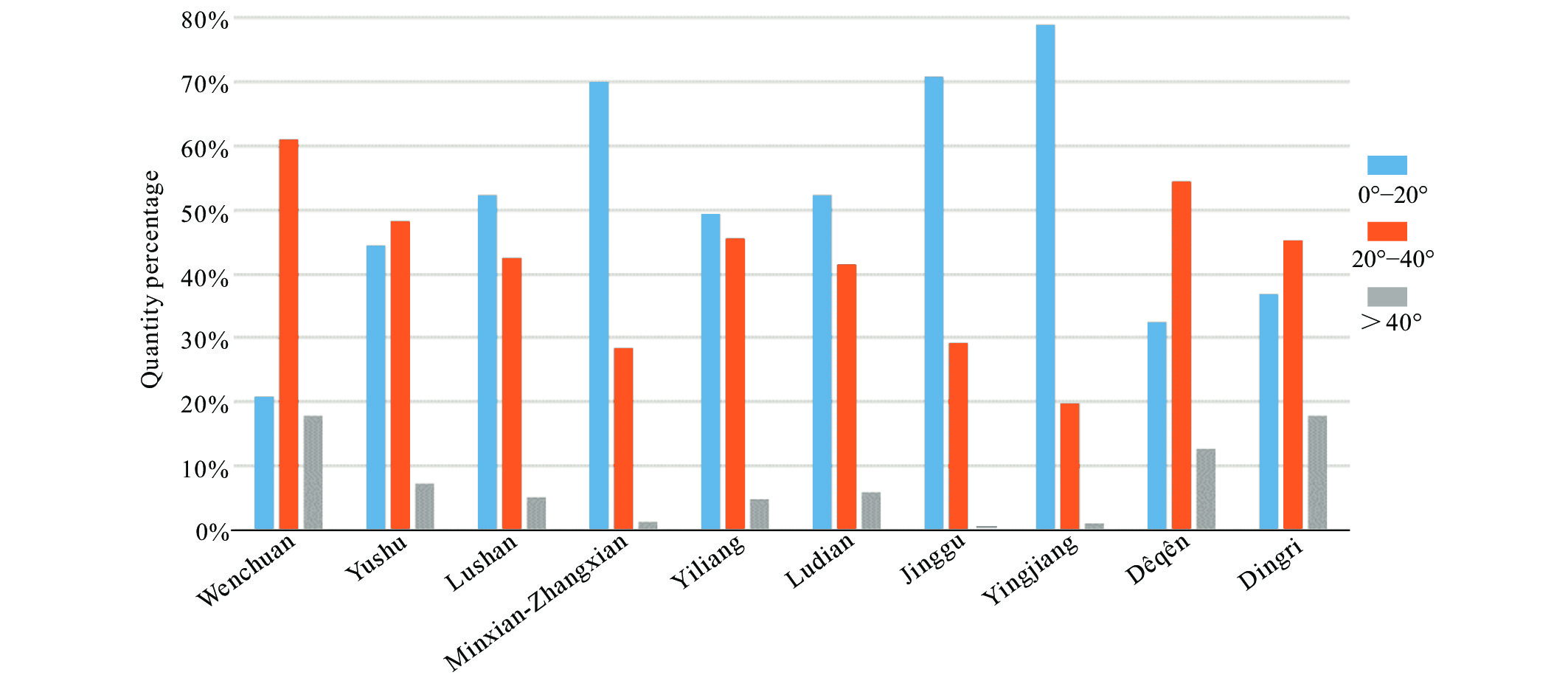| Citation: | Chao Peng, Zhi-qiang Yin, Xu-jiao Zhang, Hai Shao, Ming-fei Pang, 2023. A comparative study of the main factors controlling geohazards induced by 10 strong earthquakes in Western China since the Wenchuan earthquake in 2008, China Geology, 6, 70-84. doi: 10.31035/cg2022009 |
A comparative study of the main factors controlling geohazards induced by 10 strong earthquakes in Western China since the Wenchuan earthquake in 2008
-
Abstract
Determining the main controlling factors of earthquake-triggered geohazards is a prerequisite for studying earthquake geohazards and post-disaster emergency response. By studying these factors, the geomorphic and geological factors controlling the nature, condition, and distribution of earthquake-induced geohazards can be analyzed. Such insights facilitate earthquake disaster prediction and emergency response planning. The authors combined field investigations and spatial data analysis to examine geohazards induced by seismic events, examining ten earthquakes including the Wenchuan, Yushu, Lushan events, to elucidate the main control factors of seismic geohazard. The authors observed that seismic geohazard occurrence is usually affected by many factors, among which active nature of the seismogenic fault, seismic peak ground acceleration (PGA), topographic slope and geomorphic height differences, and distance from the fault zone and river system are the most important. Compared with strike-slip earthquakes, thrust earthquakes induce more high-altitude and high-speed remote landslides, which can cause great harm. Slopes of 0°–40° are prone to secondary seismic geohazards, which are mainly concentrated 0–6 km from the river system. Secondary geohazards are not only related to seismogenic fault but also influenced by the associated faults in the earthquake area. The maximum seismic PGA and secondary seismic geohazard number are positively correlated, and the horizontal and vertical ground motions play leading and promoting roles in secondary geohazard formation, respectively. Through the research, the spatial distribution of seismic geohazards is predicted, providing a basis for the formulation of emergency response plans following disasters.
-

-
References
Chen JP, Li JF, Qin XW, Dong QJ, Sun Y. 2009. RS and GIS-based statistical analysis of secondary geological disasters after the 2008 Wenchuan Earthquake. Acta Geologica Sinica (English Edition), 83(4), 776–785. doi: 10.1111/j.1755-6724.2009.00101.x. Cui P, Zhu YY, Han YS, Chen XQ, Zhuang JQ. 2009. The 12 May Wenchuan earthquake-induced landslide lakes: Distribution and preliminary risk evaluation. Landslides, 6(3), 209–223. doi: 10.1007/s10346-009-0160-9. Chen XL, Li CY, Wang MM, Li ZF. 2011. The main factors causing the seismic landslide distribution different on two side of the faults‒A case of landslide distribution in Beichuan area. Chinese Journal of Geophysics, 54(3), 737–746 (in Chinese with English abstract). doi: 10.3969/j.issn.0001-5733.2011.03.013. Cui SH, Yang QW, Pei XJ, Huang RQ, Guo B, Zhang WF. 2020. Geological and morphological study of the Daguangbao landslide triggered by the MS 8.0 Wenchuan earthquake, China. Geomorphology, 370, 107394. doi:10.1016/j.geomorph.2020.107394 Ding YH, Wang YQ, Sun JZ. 1999. Correlation between seismic landslide and collapse and seismic parameters and its application in predicting slope earthquake disaster. Chinese Journal of Geophysics, 42(S1), 101–107 (in Chinese with English abstract). doi: 10.1016/S0009-2541(98)00159-4. Dai FC, Xu C, Yao X, Xu L, Tu XB, Gong QM. 2011. Spatial distribution of landslides triggered by the 2008 MS 8.0 Wenchuan earthquake, China. Journal of Asian Earth Sciences, 40(4), 883–895. doi:10.1016/j.jseaes.2010.04.010 Huang RQ, Li WL. 2009. Fault effect analysis of geo-hazard triggered by Wenchuan earthquake. Journal of Engineering Geology, 17(1), 19–28 (in Chinese with English abstract). doi: 10.3969/j.issn.1004-9665.2009.01.003. Huang RQ, Zhang WF, Pei XJ. 2014. Engineering geological study on Daguangbao landslide. Journal of Engineering Geology, 22(4), 557–585 (in Chinese with English abstract). doi: 10.13544/j.cnki.jeg.2014.04.004. Han YS, Liang C, Cui P, Han J, Xue J, Zhang YX. 2010. Susceptibility of mountain hazards triggered by Wenchuan earthquake to topographic factors. Journal of Sichuan University (Engineering Science Edition), 42(S1), 15–21 (in Chinese with English abstract). doi: 10.15961/j.jsuese.2010.s1.001. Li XJ, Zhou ZH, Huang M, Wen RZ, Yu HY, Lu DW, Zhou YN, Cui JW. 2008. Preliminary analysis of strong-motion recordings from the magnitude 8.0 Wenchuan, China, Earthquake of 12 May 2008. Seismological Research Letters, 79(6), 844–854. doi: 10.1785/gssrl.79.6.844. Lai M, Zhu JG, Jiang P, Sun ZT, Li DH, Yu H, Long CH, Zhu YL. 2014. Ground motion data study of the 2013 Dêqên-Derong MS 5.9 Earthquake. Earthquake Research in Sichuan, (1), 5–8 (in Chinese with English abstract). doi: 10.13716/j.cnki.1001-8115.2014.01.002. Liu CZ, Wen MS, Liu YH, Liu QQ, Gu XX. 2016. Regional assessment on geological disasters in “5.12” Wenchuan seismic area, China. Hydrogeology and Engineering Geology, 43(5), 1–16 (in Chinese with English abstract). doi: 10.16030/j.cnki.issn.1000-3665.2016.05.01. Liu LJ, Fu HY, Zhang YB, Wang JM, Wang QD, Xiang CL, Cheng QG. 2020. DDA simulation of the mobility of Daguangbao landslide considering the frictional weakening of sliding bed. Journal of Engineering Geology, 28(6), 1221–1232 (in Chinese with English abstract). doi: 10.13544/j.cnki.jeg.2019-307. Lan J, Chen XL. 2020. Evolution characteristics of landslides triggered by 2008 MS 8. 0 Wenchuan earthquake in Yingxiu area. Seismology and Geology, 42(1), 125–146 (in Chinese with English abstract). Qi SW, Xu Q, Lan HX, Zhang B, Liu JY. 2011. Spatial distribution analysis of landslides triggered by May 12 2008 Wenchuan Earthquake, China. Engineering Geology, 116(1-2), 95–108. doi: 10.1016/j.enggeo.2010.07.011. Song ZC, Zhao LH, Li L, Zhang YB, Tang GP. 2018. Distinct element modelling of a landslide triggered by the May 12 Wenchuan earthquake: A case study. Geotechnical and Geological Engineering, 36(4), 2533–2551. doi: 10.1007/s10706-018-0481-3. Tang C, Zhu J, Qi X, Ding J. 2011. Landslides induced by the Wenchuan earthquake and the subsequent strong rainfall event: A case study in the Beichuan area of China. Engineering Geology, 122(1–2), 22–33. doi: 10.1016/j.enggeo.2011.03.013. Wang XY, Nie GZ, Wang DW. 2010. Research on relationship between landslides and peak ground acceleration induced by Wenchuan earthquake. Chinese Journal of Rock Mechanics and Engineering, 29(1), 82–89 (in Chinese with English abstract). Wang XY. 2010. Study of fast evaluation technique of earthquake-induced landslides and their effects on earthquake emergency rescue. Chinese Journal of Rock Mechanics and Engineering, 29(10), 2159 (in Chinese with English abstract). Wang XY, Wang DW. 2011. Relationships between the Wenchuan earthquake -induced landslide and peak ground velocity, Sichuan, China. Geological Bulletin of China, 30(1), 159–165 (in Chinese with English abstract). doi: 10.3969/j.issn.1671-2552.2011.01.017. Wang YF, Cheng QG, Zhu Q. 2012. Inverse grading analysis of deposit from rock avalanches triggered by Wenchuan earthquake. Chinese Journal of Rock Mechanics and Engineering, 31(6), 1089–1106 (in Chinese with English abstract). doi: 10.3969/j.issn.1000-6915.2012.06.002. Wang DP, He SM, Ge SJ, Pan CP, Zhai MG. 2013. Mountain hazards induced by the earthquake of Sep 07, 2012 in Yiliang and the suggestions of disaster reduction. Journal of Mountain Science, 31(1), 101–107 (in Chinese with English abstract). doi: 10.3969/j.issn.1008-2786.2013.01.014. Wang Y, Yang YD, Yan XS, Tang P, Zhang, J. 2016. Characteristics and causes of super-huge secondary geological hazards induced by Ms 6.5 Ludian earthquake in Yunnan. Journal of Catastrophology, 31(1), 83–86 (in Chinese with English abstract). doi: 10.3969/j.issn.1000-811X.2016.01.017. Wu XN, Yi JM, Zhou SL, Yin ZQ, Xu YQ. 2017. A study on the active faults structures and geohazards triggered by the MS 8.1 earthquake in Nepal. Hydrogeology and Engineering Geology, 44(4), 137–144 (in Chinese with English abstract). doi: 10.16030/j.cnki.issn.1000-3665.2017.04.21. Wu WY, Xu C, Wang XQ, Tian YY, Deng F. 2020. Landslides triggered by the 3 August 2014 Ludian (China) Mw 6.2 Earthquake: An updated inventory and analysis of their spatial Distribution. Journal of Earth Science, 31(4), 853–866. doi: 10.1007/s12583-020-1297-7. Xu Q. 2010. Study on Large-scale Landslides in Wenchuan Earthquake. Beijing, Science Press, 1–12 (in Chinese). Xu C, Xu XW, Yu G. H. 2012. Study on the characteristics, mechanism, and spatial distribution of Yushu earthquake trigged landslides. Seismology and Geology, 34(1), 47–62 (in Chinese with English abstract). doi: 10.3969/j.issn.0253-4967.2012.01.006. Xu YQ, Yin ZQ, Sa LP. 2016. Developing characteristics and evolution process of Ganjiazhai large scale landslide in Ludian 3rd August earthquake area of northeast Yunnan. Journal of Engineering Geology, 24(4), 550–558 (in Chinese with English abstract). doi: 10.13544/j.cnki.jeg.2016.04.009. Xiao WB, Chen YY, Wang YB, Zhang YS. 2020. Reginal seismic wave propagation modeling and ground motion characteristics of the 2013 MS 3rd August Minxian earthquake in Gansu. Chinese Journal of Geophysics, 63(5), 1816–1829 (in Chinese with English abstract). doi: 10.6038/cjg2020N0373. Yuan RM, Tan XB, Chen GH, Xu XW. 2010. Huge landslides occurred at the special places of the coseismic rupture and their mechanism explanation based on the formation model of tectonic-geomorphology: A case study of Donghekou ejection landslide. Earth Science Frontiers, 17(5), 243–253 (in Chinese with English abstract). doi: 10.1017/S0004972710001772. Yin YP, Zheng WM, Li XC, Sun P, Li B. 2011. Catastrophic landslides associated with the MS 8.0 Wenchuan earthquake. Bulletin of Engineering Geology and the Environment, 70(1), 15–32. doi: 10.1007/s10064-010-0334-7. Yin YP, Zhang YS. 2012a. Wenchuan earthquake engineering geology and geological disaster. Beijing, Science Press, 375–385 (in Chinese). Yin YP, Wang M, Li b, Feng Z. 2012b. Dynamic response characteristics of Daguangbao landslide triggered by Wenchuan earthquake. Chinese Journal of Rock Mechanics and Engineering, 31(10), 1969–1982 (in Chinese with English abstract). doi: 10.3969/j.issn.1000-6915.2012.10.003. Yang J, Zeng ZX, Li MH, Fang YG, Tan ZS, Wu SZ, Gong, C. 2015. The seismo-geological hazards and seismogenic structure of the 2013 Dêqêng-Derong 5.9 earthquake. Earth Science-Journal of China University of Geosciences, 40(10), 1701–1709 (in Chinese with English abstract). doi: 10.3799/dqkx.2015.153. Yin YP, Wang WP, Li B, Zhang N, Li HT. 2016. Study of stratigraphic site effect on the failure mechanism of Donghekou rockslide triggered by Wenchuan earthquake. China Civil Engineering Journal, 49(S2), 126–131 (in Chinese with English abstract). doi: 10.15951/j.tmgcxb.2016.s2.022. Yin ZQ, Xu YQ, Chen HQ, Sa LP, Jiang XW. 2016. The development and distribution characteristics of geohazards induced by August 3, 2014 Ludian earthquake and comparison with Jinggu and Yingjiang earthquake. Acta Geologica Sinica, 90(6), 1086–1097 (in Chinese with English abstract). doi: 10.3969/j.issn.0001-5717.2016.06.003. Yin ZQ, Zhao WJ, Xu YQ, Sa LP. 2017. Distribution characteristics of geohazards induced by the Ludian earthquake on 3 August, 2014 and a comparison to the Jinggu and Yingjiang earthquakes. Advancing Culture of Living with Landslides, 4, 95–110. doi: 10.1007/978-3-319-53485-5_11. Yang XY, Yao YH. 2018. Development law and distribution characteristics of geological hazards after “8.03” earthquake in Ludian, Yunnan Province. China Earthquake Engineering Journal, 40(5), 1078–1083 (in Chinese with English abstract). doi: 10.3969/j.issn.1000-0844.2018.05.1078. Zhou BG, Zhang YM. 1994. Some characteristics of earthquake induced landslide in Southwestern China. Northwestern Seismological Journal, 16(1), 95–103 (in Chinese with English abstract). Zhang YS, Dong SW, Hou CT, Guo CB, Yao X, Li B, Du JJ, Zhang JG. 2013. Geohazards induced by the Lushan MS 7.0 Earthquake in Sichuan Province, Southwest China: Typical examples, types and distributional characteristics. Acta Geologica Sinica (English Edition), 87(3), 646–657. doi: 10.1111/1755-6724.12076. -
Access History

-
Figure 1.
Distribution map of 10 strong earthquakes in western China (China basemap after China National Bureau of Surveying and Mapping Geographical Information; 1–10 are earthquake numbers, as shown in Tables 1–2)
-
Figure 2.
Relationship between the distribution of secondary geohazards and elevation (a) and slope (b) in Wenchuan, Lushan and Minxian-Zhangxian earthquake.
-
Figure 3.
Relationship between the distribution of secondary geohazards and elevation (a) and slope (b) in Yushu earthquake.
-
Figure 4.
Relationship between the distribution of secondary geohazards and elevation (a) and slope (b) in Yiliang and Ludian earthquake.
-
Figure 5.
Relationship between the distribution of secondary geohazards and elevation (a) and slope (b) in Jinggu and Yingjiang earthquake.
-
Figure 6.
Relationship between the distribution of secondary geohazards and elevation (a) and slope (b) in Dêqên earthquake.
-
Figure 7.
Relationship between the distribution of secondary geohazards and elevation (a) and slope (b) in Dingri earthquake.
-
Figure 8.
Comparison of the distribution of geohazard points in the upper/lower wall of the Beichuan-Yingxiu Fault (F1) in the Wenchuan earthquake.
-
Figure 9.
Relationship between the PGA(max) and the number of secondary geohazards.
-
Figure 10.
Relationship between topographic slope and proportion of secondary geohazards.
-
Figure 11.
Curve of the relationship between the distribution ratio of geohazards and its distance to (a) seismogenic fault , (b) associated faults and (c) river system in the earthquake area.





 DownLoad:
DownLoad:









